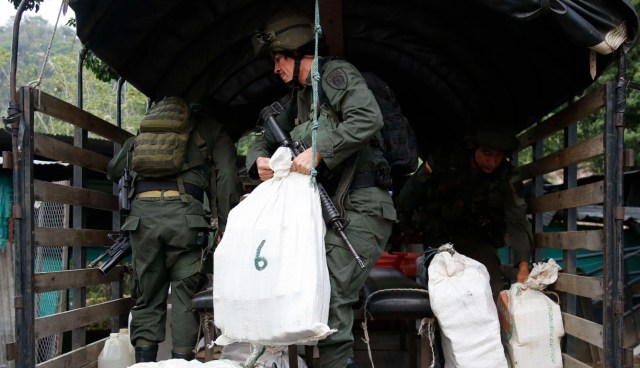
In recent months, Venezuela has restored diplomatic ties with Colombia, welcomed Colombia’s President Gustavo Petro, and agreed to host talks between Petro’s government and the ELN guerrillas. But its military continues to struggle to quiet criminal activity along the joint border.
By Insight Crime
Dec 19, 2022
In late November, Venezuela deployed military units to patrol informal border crossings, known as trochas, in the states of Apure and Táchira.
But the scale of Venezuela’s security challenge at the border is enormous. For decades, the more than 2,000 kilometers of territory separating the two countries has been home to powerful criminal groups, which were often tolerated. The closure of the border, which first began in 2008, allowed these groups to become entrenched and rake in profits from drug trafficking, human smuggling, contraband, and more.
Below, InSight Crime presents a criminal X-ray of each Venezuelan border state.
Zulia, the Ecosystem of Guerrillas and Criminal gangs
At the very north of the Venezuela-Colombia border, Venezuela’s state of Zulia borders the department of La Guajira and is the second-busiest crossing point for migrants. The desert in the north of the state facilitates the crossing of migrants and contraband food and fuel through trochas while, to the south, Zulia is a busy hub for cocaine production and trafficking.
The south has seen violence due to the National Liberation Army (Ejército de Liberación Nacional – ELN) clashing with the 33rd Front of the ex-FARC mafia, a loosely connected network of criminal groups that splintered off from the defunct Revolutionary Armed Forces of Colombia (Fuerzas Armadas Revolucionarias de Colombia – FARC) after the latter demobilized in 2016. The two groups are fighting to control drug trafficking across the border, with the ELN supported by local gangs connected to the Wayuu Indigenous people.
These criminal activities are reportedly facilitated by members of the security forces, who allow goods and people to cross the border in exchange for a fee, according to local residents interviewed by InSight Crime.
But criminal groups have also set up a form of local governance. The ELN, in particular, exercises social control over various communities, with their connection to the population providing a support network that helps the group evade armed forces.
Táchira, the ELN’s Commercial Center
With three bridges linking the two countries, Táchira is where most legal commerce and migration with Colombia has traditionally taken place.
After the 2008 border closure, the state retained this status as goods and drugs continued to flow through over 250 informal crossing points. As in Zulia, the ELN has established its own form of criminal governance, making it the criminal master of this part of the border. According to InSight Crime investigations, the ELN has maintained control over much of Táchira with a presence in 14 of the state’s 29 municipalities. The guerrilla group charges a fee for the passage of people and contraband, again with the alleged involvement of security forces and politicians who are paid off for their cooperation.
Favors are made on both sides. During Venezuela’s 2021 regional elections, when Bernal was elected governor of Táchira, the ELN allegedly worked hand-in-hand with his security forces to attack rival criminal groups.
However, a newcomer is threatening the ELN’s control in Táchira. The Tren de Aragua, Venezuela’s most powerful homegrown criminal gang, has ramped up the violence to seize control of the trochas.
Apure, a Microcosm of Organized Crime
The southwest state of Apure is famous for its agricultural production and fertile land. However, Venezuela’s economic crisis has devastated its cattle ranching industry, which has played right into the hands of Colombian criminal groups.
The south of Apure is dotted with clandestine airstrips built to send cocaine-laden planes to Central América. At the same time, InSight Crime fieldwork has also noted that cocaine production is rising there. And in northern Apure, gasoline and cattle are commonly smuggled into Colombia.
Since 2000, when then-President Hugo Chávez began to see the value in allying with the guerrillas, Apure became an operational base for the ELN and the FARC. But after a violent war with the ex-FARC mafia in 2022, the ELN became the dominant actor there.
Apure is also home to the Bolivarian Liberation Forces (Fuerzas Bolivarianas de Liberación – FBL), also known as the Patriotic Forces of National Liberation (Fuerzas Patrióticas de Liberación Nacional – FPLN), a Venezuelan guerrilla group. They are primarily based in La Gabarra, a small town in the municipality of Paez, where their deep-rooted connections to politicians and the armed forces have kept the ELN at bay.
Amazonas, the Jungle Shelter for Colombian Criminal Groups
The southernmost state of Venezuela, bordering Brazil and Colombia, Amazonas’ thick jungle, extensive river network, and gold deposits have attracted the ELN and the Acacio Medina Front, one of the most powerful ex-FARC mafia groups.
The Yapacana National Park, in the center of Amazonas, is a haven for illegal mining, while the north of the state is a thoroughfare for cocaine headed to Brazil. River highways and scarce law enforcement make it easy to keep cocaine flowing and smuggle food and gasoline.
The state’s criminal control is divided in two, with the ELN running the north and the Acacio Medina Front dominating illegal mining in the south. Both groups impose their own rules on residents, but Indigenous communities have put up stronger resistance in Amazonas than in other Venezuelan border states.
…
Read More: Insight Crime – Why Venezuela’s Army Faces Uphill Battle to Quell Colombia Border
…

